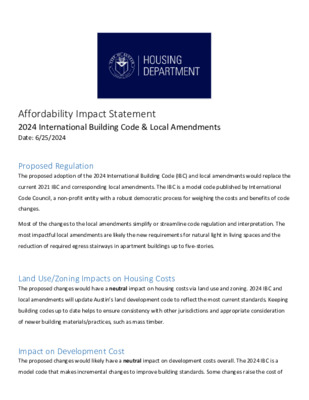12 Affordability Impact Statement June 2024 — original pdf
Backup

Affordability Impact Statement 2024 International Building Code & Local Amendments Date: 6/25/2024 Proposed Regulation The proposed adoption of the 2024 International Building Code (IBC) and local amendments would replace the current 2021 IBC and corresponding local amendments. The IBC is a model code published by International Code Council, a non-profit entity with a robust democratic process for weighing the costs and benefits of code changes. Most of the changes to the local amendments simplify or streamline code regulation and interpretation. The most impactful local amendments are likely the new requirements for natural light in living spaces and the reduction of required egress stairways in apartment buildings up to five-stories. Land Use/Zoning Impacts on Housing Costs The proposed changes would have a neutral impact on housing costs via land use and zoning. 2024 IBC and local amendments will update Austin’s land development code to reflect the most current standards. Keeping building codes up to date helps to ensure consistency with other jurisdictions and appropriate consideration of newer building materials/practices, such as mass timber. Impact on Development Cost The proposed changes would likely have a neutral impact on development costs overall. The 2024 IBC is a model code that makes incremental changes to improve building standards. Some changes raise the cost of construction in the interest of improving factors such as safety, accessibility, and code consistency. Other code changes decrease costs through means such as eliminating unnecessary requirements, providing clarification, or allowing greater design flexibility. The wider cost benefits of improved building safety, resilience, consideration of newer technology, and consistency with other jurisdictions’ building codes can counterbalance immediate building cost increases as well. 2024 Model Code Update: Research from the University of Florida is currently underway to evaluate the cost impact of updating from the 2023 Florida Building Codes to the 2024 International Codes (Issa et al. 2024).1 The 2023 Florida Building Code adopts the 2021 IBC as its model, so it may be a fair baseline to understand the overall cost impact of the changes from the 2021 IBC to the 2024 IBC. The State of Florida does adopt amendments to the model codes, but they have the closest available comparison to understand the cost impacts of adopting the 2024 IBC. The University of Florida study models the adoption of the 2024 International Codes on seven different building types, including small office, retail, primary school, small hotel, mid-rise apartment, 1-story residence, and 2-story residence. The average net change in cost estimate between all the building types is +0.45% (ranging from +0.11% for 1-story residences to +0.84% for small hotel). This study highlights 479 changes to the IBC that are prescriptive, finding that 62 (~13%) will decrease the cost of construction, 31 (~7%) will increase the cost of construction, and the remaining 386 will have neutral impacts. After weighing the likely impacts of the ~19% of prescriptive IBC code changes that will impact construction costs, it appears likely that there will be a neutral impact overall. Local Amendments: Aside from the following items, most changes to the local amendments for 2024 simplify language, delete unnecessary requirements, and create greater consistency with the IBC and other model codes. The most significant local amendments to the IBC appear to be the new natural light requirements, air conditioning requirements, and single stair allowance for certain apartment buildings. A previous affordability impact statement for natural light requirements determined a neutral impact from this code amendment due to the benefits of access to natural light outweighing the costs to development. The new air conditioning requirements enshrine in code what is already a basic health and safety necessity for Texas. The allowance for a single stair design applies to apartment buildings that are no more than five stories tall and have no more than 4 dwelling units on any floor; this will allow greater design flexibility and may decrease construction costs for these buildings. 1 Including the IBC, International Mechanical Code (IMC), International Plumbing Code (IPC), International Fuel & Gas Code (IFGC), International Residential Code (IRC), and International Existing Buildings Code (IEBC). The update impacts from the 2020 National Electric Code were also summarized. Impact on Affordable Housing The proposed changes would have a neutral impact on affordable housing. The above points about development costs also generally apply to affordable housing. Modeling from the University of Florida finds that the changes between the 2021 and 2024 International Codes result in an estimated 0.63% increase in mid-rise apartment construction, largely driven by HVAC and electrical changes (Issa et al. 2024). Deeply affordable housing often takes the form of multifamily apartment developments, so this is the most relevant typology to model. This marginal increase in cost of construction is likely the result of changes to the mechanical and electrical codes, not the IBC. The cost increase may also be balanced by the benefits of code standardization and marginal improvements to safety and resilience. City Policies Implemented None. Other Housing Policy Considerations Building codes are important for ensuring baseline safety for structures. It is also helpful for the development process when codes are largely consistent between jurisdictions because there is less burden on builders to understand unique regulations. Ensuring consistent baseline safety standards for buildings has strong benefits, but having such standards inevitably creates development costs. These costs put extra burden on the community and the City to ensure that everyone can afford to enjoy the benefits of safe construction. Manager’s Signature ________